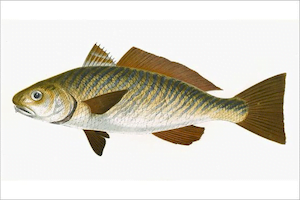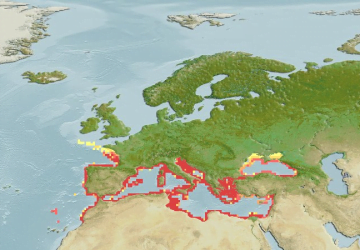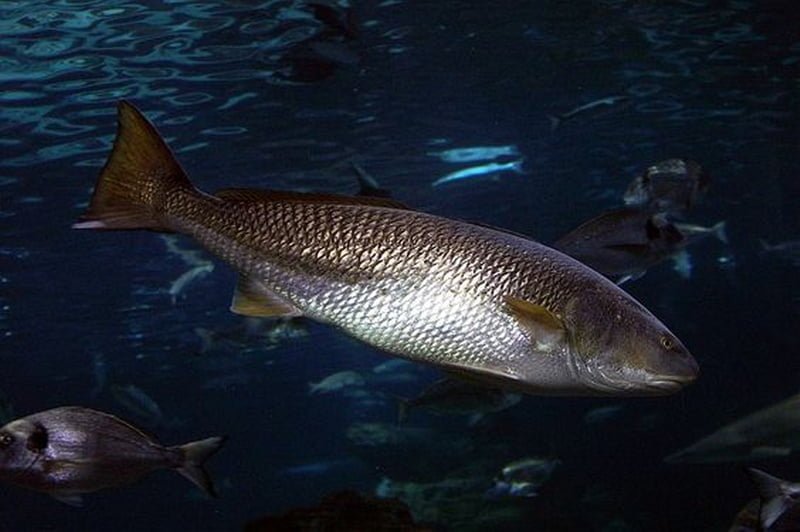Umbrina Cirrosa
– Shi Drum –

| Conservation status |
|---|
 Vulnerable (IUCN 3.1)[1] |
| Scientific classification |
Umbrina cirrosa
(Linnaeus, 1758)[2]
| Kingdom: | Animalia |
| Phylum: | Chordata |
| Class: | Actinopterygii |
| Order: | Perciformes |
| Family: | Sciaenidae |
| Genus: | Umbrina |
| Species: | U. cirrosa |


Umbrina cirrosa, the shi drum, is a species of marine fish from the warmer waters of the eastern Atlantic Ocean, Mediterranean Sea and the Black Sea. It is a commercially important species which is trawled for and farmed in aquaculture, as well as being a species pursued by anglers and spear fishermen for sport. The alternative vernacular names are gurbell, sea crow, bearded umbrine and corb.
Description
Umbrina cirrosa has a moderately elongated body which is deep and laterally compressed, the ventral surface is rectilinear. Its small mouth has an inferior setting and contains villiform teeth while on its chin there is a short and rigid barbel which is perforated by a pore at its tip. Its scales are mainly ctenoid in form except for those on the breast, snout and sub-orbital region, where they are predominantly cycloid. It is greyish-silver to brownish in colour, with a metallic sheen and is marked with longitudinal dark lines on the dorsal regions; the membranes on hind margin of gill cover are jet black in colour while the fins are dusky.[3] The maximum length recorded is 73 cm total length, although the average is 40 cm.[2]
A chin barbel is present under the jaw, which is itself oriented in a lower position (the jaw of the umbrellas is of the prognath type *). It has two distinct dorsal fins. A black membrane is present at the posterior edge of the operculum * . Her dress is silver gray. On its back and flanks, irregular oblique golden yellow streaks with dark borders are characteristic. The ventral part is silvery white. The caudal fin is slightly concave at edge. The fins are whitish in color.
Distribution
Umbrina cirrosa is found in the eastern Atlantic Ocean from the Bay of Biscay to southern Morocco and in the Mediterranean, although it is not found around the larger islands, and Black Sea and Sea of Azov.[1] It has also spread into the Gulf of Suez through the Suez Canal,[3] one of the few Lessepsian migrants to go from the Mediterranean to the Red Sea, known as anti-Lessepsian migrants.[4]
Biotope
Juvenile, the umbrellas remain near the mouths of rivers. Adult it is a sedentary fish sometimes living in groups on sandy, muddy and sometimes rocky bottoms. It is found between a few meters and 100 meters deep.
Similar Species
The following species are from the same family (Sciaenidae), for the general appearance and arrangement of the fins:
Argyrosomus regius (lean): fish with a longer body, clear and silvery. Good swimmer, can evolve in open water. Bigger mouth. No barbel.
Sciaena umbra (corb): predominantly dark body (bronze). Dark fins (pelvic and anal black, edged white inside). No barbel. Placid behavior with an easy approach.
Umbrina canariensis (bronze ombrine): predominantly dark body (bronze). Dark fins. 2nd dorsal and caudal fin edged in black.
Umbrina ronchus (omien fusca): dark brown body. Pelvic, anal and lower caudal fins black. Rather deep species.
Habitat and Behaviour
Umbrina cirrosa is a demersal species which is found in inshore waters,[3] over both rock and sandy sea beds.[1] The juveniles occur in estuaries.[2] The males produce pulses of sound to attract the females[5] and spawning begins in May and peaks in June,[1] the eggs being scattered over the substrate, each female lays more than one batch of spawn.[2] The prey taken by this species includes on sardines, anchovies, mackerels, cuttlefish, molluscs and worms,[1] but the main prey are benthic invertebrates.[3]
Alimentation
It is a carnivorous fish that feeds in small groups of invertebrates found in the sand. Its preferred prey are crustaceans, molluscs and echinoderms.
Reproduction
Reproduction takes place in spring, between May and June. The young up to 3 cm are blackish with white fins.
Various Biology
The first dorsal fin has 10 spiny rays, the second has 22-25 soft rays. The anal fin has 2 hard rays and 7-8 soft rays.
On May 29, 2011, a specimen of enormous size (1.96 m in length and 74 kg) was captured in the Sea of Marmara, near the coast of Bursa province in Turkey, where the species is called Minekop.
Fisheries
Umbrina cirrosa has been recorded as being landed by fishermen in seven Mediterranean countries, the largest catches have been in Turkey and Italy. There has been a steep decline in landings in these two countries over the last ten years. The average landing figures for the years 1986 to 1990 were 1,393t and this has declined by 80% compared with the average figures for the years 2001 to 2005 being 278t.[1] In the European Union over 1,000t was landed in 1995 but this had fallen to less than 100t by 2008.[6] The species is now being farmed in aquaculture in countries such a Cyprus.[7] The European record for a fish caught by an angler is 11.2 kg, this fish was caught in 1992 off Corsica.[8] This species is also pursued by spear fishers.[9]
Further Information
The presence of the parasol in captivity is rare but it is visible in aquariums in Barcelona (Spain) and Genoa (Italy).
“Shi drum”, the English term would come from the fact that the fish makes a drum noise when it hits its tail once out of the water …







































































































































































































































































































































































